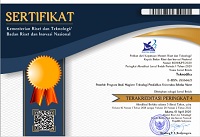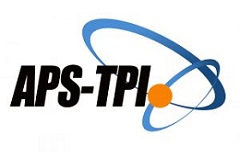Development of Valid, Practical, and Potential Web-Based Learning Materials for Higher Education
Abstract
Keywords
Full Text:
PDFReferences
Abdillah, R., Sunardi, S., & Ardianto, D. T. (2018). Pengembangan Aplikasi Multimedia Pembelajaran CD Tutorial Pada Mata Kuliah Berbasis Praktik. Teknodika, 16(1), 53. https://doi.org/10.20961/teknodika.v16i1.34755
Agudo-Peregrina, A., Iglesias-Pradas, S., Conde-González, M., & Hernández-García, Á. (2014). Can We Predict Success from Log Data in VLEs? Classification of Interactions for Learning Analytics and Their Relation with Performance in VLE-Supported F2F and Online learning. Computers in Human Behavior, 31, 542–550. https://doi.org/10.1016/j.chb.2013.05.031
Alexander, B. (2006). Web 2.0: A New Wave of Innovation for Teaching and Learning? Educause Review, 41, 32–44.
Bofill, M. (2022). Transformation of Our Understanding and Impactful Influences. 13(2), 1549–1553.
Burns Sardone, N. (2014). Making the Case for BYOD Instruction in Teacher Education. Issues in Informing Science and Information Technology, 11(August), 191–201. https://doi.org/10.28945/1988
Christensen, R. (2002). Effects of technology integration education on the attitudes of teachers and students. Journal of Research on Technology in Education, 34(4), 411–433. https://doi.org/10.1080/15391523.2002.10782359
Davidson-Shivers, G. V., Rasmussen, K. L., & Bratton-Jeffery, M. F. (1997). Investigating Learning Strategies Generation in a Hypermedia Environment Using Qualitative Methods. J. Comput. Child. Educ., 8(2), 247–261.
Davidson-Shivers, G. V, Rasmussen, K. L., & Lowenthal, P. R. (n.d.). Web-based learning. Prentice Hall.
Doherty, S., & O’Brien, S. (2014). Assessing the Usability of Raw Machine Translated Output: A User-Centered Study Using Eye Tracking. International Journal of Human–Computer Interaction, 30(1), 40–51. https://doi.org/10.1080/10447318.2013.802199
Handayani, T., Maulida, E., & Sugiyanta, L. (2020). Blended Learning Implementation and Impact in Vocational Schools. Teknodika, 18(2), 146. https://doi.org/10.20961/teknodika.v18i2.42032
Isa, Y., & Diningrum, J. K. (2019). Jurnal BaJET PENGEMBANGAN MEDIA PEMBELAJARAN MODUL. 6(2), 395–400.
Khaerotin, R. (2019). Pengembangan Multimedia Interaktif 3D Aurora Presentation Untuk Keterampilan Menulis Bahasa Arab. Al Mahāra: Jurnal Pendidikan Bahasa Arab, 5(1), 1–18. https://doi.org/10.14421/almahara.2019.051-01
Lasfika, Y. T., Widyastono, H., & ... (2022). Digitalization Android-based Interactive Learning Media in Geography for High School Students. Journal of Education …, 6(2), 207–216. https://ejournal.undiksha.ac.id/index.php/JET/article/view/44674%0Ahttps://ejournal.undiksha.ac.id/index.php/JET/article/download/44674/22183
Mayer, R. E., & Moreno, R. (2003). Nine Ways to Reduce Cognitive Load in Multimedia Learning. Educational Psychologist, 38(1), 43–52. https://doi.org/10.1207/S15326985EP3801_6
Morphew, V. N. (2000). Web-Based Learning and Instruction: A Constructivist Approach. Distance Learn. Technol. Issues Trends Oppor. 1–15.
Mudyahardjo, R. (2001). Pengantar pendidikan: Sebuah Studi Awal Tentang Dasar-Dasar Pendidikan pada Umumnya dan Pendidikan di Indonesia. Raja Grafindo Persada.
Parkay, F. W., Stanford, B. H., & Gougeon, T. D. (2010). Becoming a Teacher. Pearson/Merrill.
Qosim, A., & Susila, H. R. (2018). Pengembangan Multimedia Interaktif Merakit Personal Computer (PC). Lentera Pedagogi, 1(2), 98–108.
Roemintoyo, R., Miyono, N., Murniati, N. A. N., & Budiarto, M. K. (2022). Optimising the utilisation of computer-based technology through interactive multimedia for entrepreneurship learning. Cypriot Journal of Educational Sciences, 17(1), 105–119. https://doi.org/10.18844/cjes.v17i1.6686
Rowntree, D. (1994). Preparing Materials for Open, Distance and Flexible Learning: An Action Guide for Teachers and Trainers. Kogan Page.
Rusman, D. K., & Riyana, C. (2011a). Pembelajaran Berbasis Teknologi Informasi dan Komunikasi. Rajawali Pers.
Rusman, D. K., & Riyana, C. 2011. (2011b). Pembelajaran Berbasis Teknologi Informasi dan Komunikas. Rajawali Pers.
Schwier, R. E. R. M. (1993). Interactive Multimedia Instruction. Educational Technology Publications, Inc.
Smaldino, S. E., Lowther, D. L., & Mims, C. (2012). Instructional Media and Technology for Learning. International Journal of Distributed and Parallel Systems, 3, 8.
Tessmer, M. (1998). Planning and Conducting Formative Evaluation. Kogan Page.
Wick, C. W., & Leon, L. S. (1995). From Ideas to Action: Creating a Learning Organization. Hum. Resour. Manage., 34, 299–311.
Refbacks
- There are currently no refbacks.





.png)













